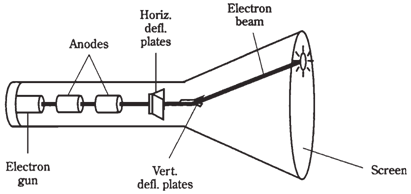Cathode-ray tubes
Everyone encounters TV picture tubes in day to day life. You have almost certainly looked at the computer monitor (even the cash registers have them now), and you have probably seen an oscilloscope in some of the form. These video displays use cathode-ray tubes (known as CRTs).
The electron beam
In any CRT, the electron gun emits a high-intensity stream of electrons. This beam is then focused and accelerated as it passes through the anodes which carry positive charge. The anodes of a CRT work in a different way than anode of a radio frequency vacuum tube. Instead of hitting the anode, electrons pass on until they strike a screen whose inner surface is coated by phosphor. The phosphor glows as seen from the face of CRT.Unless deflection is used to move electron beam around the screen of CRT, you will only get a brilliant spot in center of the screen. Deflection of beam makes various displays possible. The beam is deflected by electrostatic fields or by magnetic fields.
Electrostatic deflection
A cross-sectional drawing of an electrostatic CRT is shown in the figure given below. The electron beam is pulled toward positive deflecting plates and is repelled away from negative plates. There are 2 sets of deflecting plates, one for horizontal plane and other for vertical plane. The higher the voltage between the plates, the greater will be the intensity of electrostatic field, and the more the electron beam gets deflected.

Figure--Simplified cutaway view of an electrostatic CRT.
In an oscilloscope, horizontal deflecting plates receive a sawtooth voltage wave- form. This makes the beam to scan or sweep at the precise, adjustable speed across screen from left to right as seen from the outside. The vertical deflecting plates receive waveform which is to be analyzed. This waveform makes electron beam undulate up and down. The combination of horizontal and vertical motions results in display of the input waveform as a function of time. This is time domain display.
Oscilloscopes can be adapted to show phenomena as a function having some domain except time. An instance is a spectrum analyzer, showing signal amplitude as the function of frequency: a frequency-domain display. A radar set shows the distance and direction of signal echoes from objects in sky or in space; these are position do main or location-domain renditions.
Electromagnetic deflection
Coils can be used instead of charged plates for deflection of the electron beam in a CRT. When currents pass through the coils, beam alters direction at right angles to the magnetic lines of flux. Greater the current in a deflecting coil, stronger the magnetic field, and greater the extent to which the beam gets deflected. This is an electromagnetic CRT.
You can use the figure given below to imagine the workings of an electromagnetic CRT, only by thinking of coils outside the neck of the tube, instead of deflection plates inside the tube. There are 2 coils, one for horizontal deflection and other for vertical deflection.